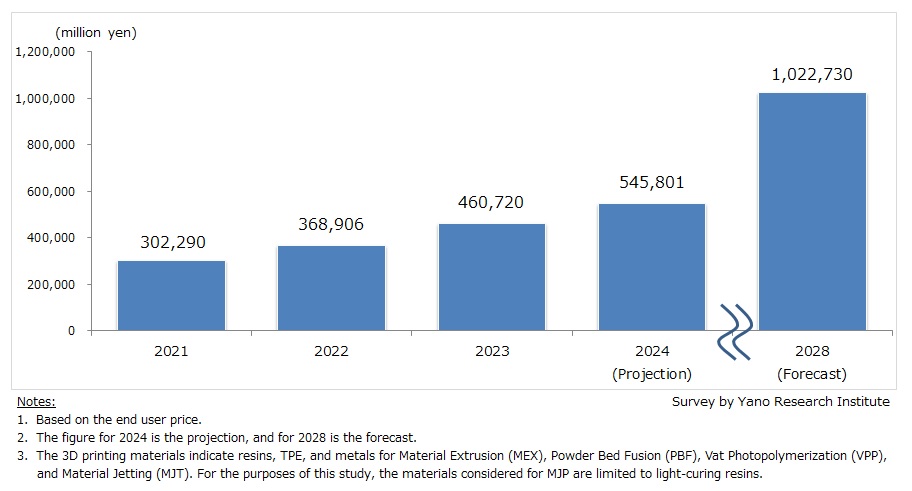No.3669
Global 3D Printing Materials Market: Key Research Findings 2024
Global 3D Printing Materials Market Grew by 24.9% Year-on-Year to 460,720 Million Yen in 2023
Yano Research Institute (the President, Takashi Mizukoshi) has conducted a survey on the global 3D printing materials market, and found out the trends by 3D printing type, the trends of market players, and future perspectives.

Market Overview
The global 3D printing materials market size in 2023 was valued at 460,720 million yen (124.9% of the preceding year, based on the end user price).
When examining the market by 3D printing type, materials for material extrusion (MEX) are seeing robust growth, driven by steady demand from both individual users and the increasing need from industries for MRO inventory (supplies, spare parts, and other materials essential for maintenance, repair, and operations). In the case of powder bed fusion (PBF), there has been strong demand for metals in the aerospace, defense, and medical sectors, while resin use has expanded to support production parts across a range of industries. Light-curing resin for vat photopolymerization (VPP) has seen growth due to its medical applications, such as dental models and hearing aid components. Additionally, there has been robust demand for light-curing resin in material jetting (MJT), primarily for prototype production in overseas markets.
Noteworthy Topics
Trends of Materials for Material Extrusion (MEX)
The demand for MEX 3D printing spans a wide range of industries, including automotive, aerospace, medical, construction, and education, as well as consumer markets. Professional creators and hobbyists use 3D printers to make figurines, toys, and accessories, primarily with PLA, ABS, and PETG filaments. While a Taiwanese manufacturer exited the desktop 3D printer market in 2023, a new high-speed, low-cost model introduced by a Chinese startup is gaining attention.
In the automotive industry, MEX 3D printing is commonly used for creating prototypes to evaluate designs or functionalities (such as large components like bumpers), as well as jigs and custom parts for car modifications and the aftermarket.
In aerospace, manufacturers are using MEX 3D printers with high-performance engineering plastics to produce ducting, brackets, switches, and even engine components for satellites. A rebound in capital investments—following a period of stagnation due to the COVID-19 pandemic—along with advancements in 3D printing technologies, has driven increased demand for CFR and GFR filaments.
Future Outlook
With advancements in 3D printing technologies and innovations in materials—such as those offering enhanced mechanical properties and heat resistance—the potential applications for 3D printed prototypes, jigs, and small- to medium-volume parts are expected to expand significantly. Given this outlook, the global market for 3D printing materials is projected to exceed one trillion yen by 2028, growing at a compound annual growth rate (CAGR) of 17.3% from 2023 to 2028.
Research Outline
2.Research Object: Businesses related to 3D printing (printer manufacturers, material manufacturers)
3.Research Methogology: Face-to-face interviews by the expert researchers (including online interviews) and literature research
What is the 3D Printing Materials Market?
A wide range of materials are being developed and utilized for different 3D printing technologies, including resins, thermoplastic elastomers (TPE), metals, ceramics, wax, and gypsum. In addition, various additives are incorporated into the 3D printing process, such as binding agents for binder jetting (BJ), reinforcing compounds, conductive materials, and colorants.
This report focuses on key 3D printing materials—resins, TPE, and metals—across four primary printing technologies: Material Extrusion (MEX), Powder Bed Fusion (PBF), Vat Photopolymerization (VPP), and Material Jetting (MJT). The market size is calculated based on the end-user prices of these materials.
For the purposes of this study, the materials considered for Material Jetting are limited to light-curing resins.
<Products and Services in the Market>
Resin, thermoplastic elastomers (TPE), metals
Published Report
Contact Us
The copyright and all other rights pertaining to this report belong to Yano Research Institute.
Please contact our PR team when quoting the report contents for the purpose other than media coverage.
Depending on the purpose of using our report, we may ask you to present your sentences for confirmation beforehand.